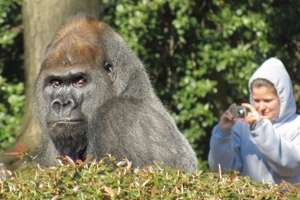Science
The Intrigue in Excrement

When Kim Kramer says she’s had a crappy day, she means it. Kim is a second year graduate student in AU’s biology department, studying stress hormones and social interaction in captive great apes. A student of College faculty members Colin Saldanha and Christopher Tudge, Kramer extracts the hormone samples for her research from fecal matter of gorillas housed at the Smithsonian Institution’s National Zoological Park in Washington, DC.
Kramer began her time at the zoo in 2012, during an internship at the Great Ape House. Focusing on regurgitation and reingestion, possible correlates of stress behavior in gorillas, she began to learn about how efforts to understand animal behavior could help inform animal care- taking practices and improve animal welfare. Kramer has been learning alongside our primate counterparts ever since. After a trip to Borneo for fieldwork, she decided to return stateside and pursue a master’s degree in biology at American University.
“I really love the longer-term connection you get doing captive work,” she says. With the acquisition of a prestigious National Science Foundation (NSF) graduate research fellowship, she again set out to pursue captive work with the support of several well-known researchers in the AU community. Here at AU, she’s begun an incredible journey toward understanding the stress that captive gorillas experience as a result of common moves from zoo to zoo.
The start of Kramer’s work at AU could not have come at a better time. In 2015, the Smithsonian took in a new female gorilla, Calaya, as a part of a recommendation from the Gorilla Species Survival Plan, an organization dedicated to the genetic health and well-being of gorillas, especially those housed in US zoos. This introduction gave Kramer the incredible opportunity to study the hormonal stress response of troop members to the introduction of a new individual, immediately before and after Calaya’s arrival.
Gorillas in zoos across the United States are often transferred from zoo to zoo to participate in breeding programs designed to maximize genetic diversity in captive gorilla populations. Just as is true for humans, however, moving to a new city (or zoo) can be extremely stressful for a gorilla.
In order to minimize this stress, we must first understand it. Though a few research studies have been conducted to examine stress and social behavior in captive gorillas, very few studies have examined behavior and hormone levels in response to the introduction of a gorilla from another zoo. This is where Kramer’s research comes in. She has examined stress hormones and behavior in two groups of gorillas at the National Zoo after the introduction of a new group member. Kim hopes that the results of her studies will help to inform stress-minimization programs already in place at zoos nationwide.
So why this talk about poop? Kramer explains that though hormones can be found in blood, saliva, and urine, the hormones you find in solid waste are representative of much longer- term buildup of hormones in the apes’ systems. Thus, examining feces gives you an opportunity to quantitatively, and non-invasively, observe how the apes have been doing over the course of the day, but also what their stress levels have looked like for the past few months. For someone studying stress in response to the introduction of a new individual, this long-term indicator is ideal.
To analyze the hormone levels present in the fecal samples she collects at the zoo, Kramer brings her samples back to Saldanha’s lab. On campus, she performs immunoassays. Using antibodies targeted at a specific molecule (cortisol, a hormone released in response to stress, in her case), Kramer is able to detect just how much cortisol is in the fecal samples from individual gorillas, and analyze how these cortisol levels change over the course of months. But after carefully analyzing fecal cortisol data from before Calaya’s arrival, a quarantine period, and after Calaya’s introduction to the one of the two zoo troops, Kramer has come up with some pretty interesting results.
Though cortisol levels increased and gradually tapered off in the troop Calaya was introduced to, cortisol levels increased in the troop Calaya was never introduced to as well. Thus, even though the other troop couldn’t physically access Calaya, they could see, hear, and smell her. Those senses alone were enough to result in increased cortisol levels in the other troop—an effect that lasted for some time. Kim tells us that these results inspire her to think about ways in which zoo enclosures could be redesigned to minimize stress in the gorillas. Perhaps zoos housing more than one troop of gorillas could build enclosures with additional barriers, or house troops in different buildings to help reduce long-term cortisol buildup in captive gorillas.
Like a true student of biology, Kramer says her favorite part about research is “creating sense out of madness”—that quest to find a pattern in a vast web of information. “You take these complex behaviors that don’t really seem to mean anything, and then when you quantify them you see that they actually tell a story.”
Though Kramer’s passion for biology and behavior has fueled her work between the Smithsonian and AU, her long-term goal is to pursue work in science policy. One of the most important ways she can utilize her editing skills and the scientific understanding she’s developed here at American University, she feels, is to communicate the importance of work like that being done in AU’s biology department to further the biological understanding of our world. We hope to hear more about her work as she transitions from her graduate program into the working world.
